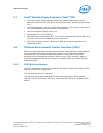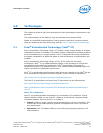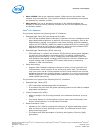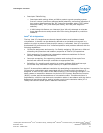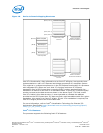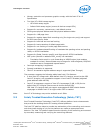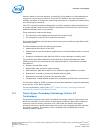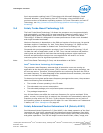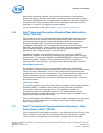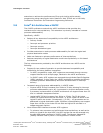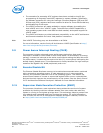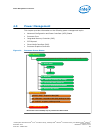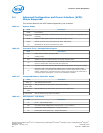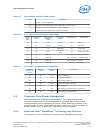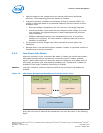
Intel recommends enabling Intel HT Technology with Microsoft Windows* 8 and
Microsoft Windows* 7 and disabling Intel HT Technology using the BIOS for all
previous versions of Windows* operating systems. For more information on Intel HT
Technology, see http://www.intel.com/technology/platform-technology/hyper-
threading/.
Intel
®
Turbo Boost Technology 2.0
The Intel Turbo Boost Technology 2.0 allows the processor core to opportunistically
and automatically run faster than its rated operating frequency/render clock, if it is
operating below power, temperature, and current limits. The Intel Turbo Boost
Technology 2.0 feature is designed to increase performance of both multi-threaded
and single-threaded workloads.
Maximum frequency is dependant on the SKU and number of active cores. No special
hardware support is necessary for Intel Turbo Boost Technology 2.0. BIOS and the
operating system can enable or disable Intel Turbo Boost Technology 2.0.
Compared with previous generation products, Intel Turbo Boost Technology 2.0 will
increase the ratio of application power to TDP. Thus, thermal solutions and platform
cooling that are designed to less than thermal design guidance might experience
thermal and performance issues since more applications will tend to run at the
maximum power limit for significant periods of time.
Note: Intel Turbo Boost Technology 2.0 may not be available on all SKUs.
Intel
®
Turbo Boost Technology 2.0 Frequency
The processor rated frequency assumes that all execution cores are running an
application at the thermal design power (TDP). However, under typical operation, not
all cores are active. Therefore, most applications are consuming less than the TDP at
the rated frequency. To take advantage of the available thermal headroom, the active
cores can increase their operating frequency.
To determine the highest performance frequency amongst active cores, the processor
takes the following into consideration:
• The number of cores operating in the C0 state.
• The estimated core current consumption.
• The estimated package prior and present power consumption.
• The package temperature.
Any of these factors can affect the maximum frequency for a given workload. If the
power, current, or thermal limit is reached, the processor will automatically reduce the
frequency to stay within its TDP limit. Turbo processor frequencies are only active if
the operating system is requesting the P0 state. For more information on P-states and
C-states, see Power Management on page 49.
Intel
®
Advanced Vector Extensions 2.0 (Intel
®
AVX2)
Intel Advanced Vector Extensions 2.0 (Intel AVX2) is the latest expansion of the Intel
instruction set. Intel AVX2 extends the Intel Advanced Vector Extensions (Intel AVX)
with 256-bit integer instructions, floating-point fused multiply add (FMA) instructions,
and gather operations. The 256-bit integer vectors benefit math, codec, image, and
3.4
3.5
Technologies—Processor
Desktop 4th Generation Intel
®
Core
™
Processor Family, Desktop Intel
®
Pentium
®
Processor Family, and Desktop Intel
®
Celeron
®
Processor Family
December 2013 Datasheet – Volume 1 of 2
Order No.: 328897-004 45



